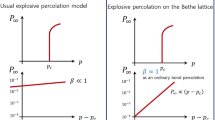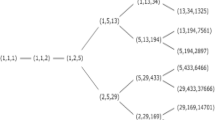Abstract
Coordination geometries describe the arrangement of the neighbours of a central particle. Such geometries can be thought to lie in an abstract topological space, a model of which could provide a mathematical basis for understanding physical transformations in crystals, liquids, and glasses. Through the generalisation of a recently proposed local order parameter, the present work conceives a metric model of the space of three-dimensional coordination geometries. This model appears to be consistent with elementary geometry and suggests a taxonomy of coordination geometries with five main classes. A quantifier of coordination-geometric typicality is derived from the metric. By the statement of a postulate on the topology of the space being modelled, the range of structures that are possible to resolve using the local order parameter is greatly increased.
Graphic abstract






Similar content being viewed by others
Data availability statement
The datasets generated during and/or analysed during the current study are available from the corresponding author on reasonable request.
References
D. Moroni, P.R. ten Wolde, P.G. Bolhuis, Phys. Rev. Lett. 94, 235703 (2005). https://doi.org/10.1103/PhysRevLett.94.235703
A.R. Natarajan, A. Van der Ven, Phys. Rev. Lett. 121, 255701 (2018). https://doi.org/10.1103/PhysRevLett.121.255701
P.N. Plessow, Phys. Chem. Chem. Phys. 22, 12939 (2020). https://doi.org/10.1039/d0cp01651a
Y.-C. Hu, H. Tanaka, Nat. Commun. 13, 4519 (2022). https://doi.org/10.1038/s41467-022-32241-z
H. Terrones, A.L. Mackay, J. Math. Chem. 15, 157 (1994). https://doi.org/10.1007/bf01277557
S.K. Kolli, A.R. Natarajan, J.C. Thomas, T.M. Pollock, A. Van der Ven, Phys. Rev. Mater. 4, 113604 (2020). https://doi.org/10.1103/physrevmaterials.4.113604
J.C. Thomas, A.R. Natarajan, A. Van der Ven, Npj Comput. Mater. 7, 164 (2021). https://doi.org/10.1038/s41524-021-00627-0
J. Çamkıran, F. Parsch, G.D. Hibbard, J. Chem. Phys. 156, 091101 (2022). https://doi.org/10.1063/5.0079985
P.J. Steinhardt, D.R. Nelson, M. Ronchetti, Phys. Rev. B 28, 784 (1983). https://doi.org/10.1103/physrevb.28.784
L. Pauling, J. Am. Chem. Soc. 51, 1010 (1929). https://doi.org/10.1021/ja01379a006
R. Staub, S.N. Steinmann, J. Chem. Phys. 152, 024124 (2020). https://doi.org/10.1063/1.5135696
R.V.L. Hartley, Bell Syst. Tech. J. 7, 535 (1928). https://doi.org/10.1002/j.1538-7305.1928.tb01236.x
A. Stukowski, Modell. Simul. Mater. Sci. Eng. 20, 045021 (2012). https://doi.org/10.1088/0965-0393/20/4/045021
H. Tanaka, H. Tong, R. Shi, J. Russo, Nat. Rev. Phys. 1, 333 (2019). https://doi.org/10.1038/s42254-019-0053-3
L. Yang, S. Dacek, G. Ceder, Phys. Rev. B 90, 054102 (2014). https://doi.org/10.1103/physrevb.90.054102
R. Hundt, J.C. Schön, M. Jansen, J. Appl. Crystallogr. 39, 6 (2006). https://doi.org/10.1107/S0021889805032450
M.Ó. Searcóid, Metric spaces (Springer, 2006), p.2
M. Ester, H.-P. Kriegel, J. Sander, X. Xu, in Proc. of 2nd International Conference on Knowledge Discovery and Data Mining( 1996) pp.226–231
Z. Bar-Joseph, D.K. Gifford, T.S. Jaakkola, Bioinformatics 17, S22 (2001). https://doi.org/10.1093/bioinformatics/17.suppl_1.s22
P.H.A. Sneath, R.R. Sokal, Numerical taxonomy (Freeman, 1973)
T.F. Cox, M.A.A. Cox, Multidimensional scaling (Chapman & Hall, 1994)
S.L. Devadoss, J. O’Rourke, Discrete and computational geometry (Princeton University Press, 2011), pp.98–117
C.J. Bradley, A.P. Cracknell, The mathematical theory of symmetry in solids: representation theory for point groups and space groups (Oxford University Press, Oxford, 2010)
E.C. Bain, N. Dunkirk, Trans. AIME. 70, 24 (1924)
W. Burgers, Physica 1, 561–586 (1934)
R.J. Gillespie, Coord. Chem. Rev. 252, 1315 (2008). https://doi.org/10.1016/j.ccr.2007.07.007
J.J. Thomson, Lond. Edinb. 7, 237 (1904). https://doi.org/10.1080/14786440409463107
M. Atiyah, P. Sutcliffe, Milan J. Math. 71, 33 (2003). https://doi.org/10.1007/s00032-003-0014-1
H. Wadell, J. Geol. 43, 250 (1935). https://doi.org/10.1086/624298
Acknowledgements
The authors would like to thank Alán Aspuru-Guzik and Chandra Veer Singh for their helpful discussions.
Author information
Authors and Affiliations
Contributions
JÇ conceived the project, obtained the results, and wrote the manuscript. FP and GDH contributed to the results and the writing.
Corresponding author
Appendices
Appendix A: Commonly encountered geometries
Table 2 lists 22 of the most commonly encountered geometries of coordination. These include 11 zero-lone-pair molecular geometries predicted by valence shell electron pair repulsion theory [26] and eight solutions of the Thomson problem [27], the latter of which also happen to be minimum-energy sphere packings for \(k \le 12\) [28]. Mathematically, these correspond to the first four Platonic solids, all eight strictly convex deltahedra, 12 capped (anti)prisms, four regular bipyramids, two circumscribable bicupolae, and the rhombic dodecahedron (a Catalan solid). Figure 5 depicts their extracopularity distances.
Appendix B: A technicality of fixed discretisation
One of the inevitabilities of the fixed approach to bond angle discretisation is the confusion of angles that are close yet unequal even in the ideal form of a coordination geometry. Among the geometries herein studied, this issue is observed to afflict those of type (X)PP, (X)SA, (X)TP, and SDS. In the analysis described in Sect. 5, we corrected their bond angle counts as follows. Let \(f_{g}(\theta )\) denote the number of close yet unequal angles that are mapped to the class representative \(\theta \) for a coordination geometry g. Then, our correction to \(\left|\Theta _{gh}\right|\) is given by
Appendix C: Miscellaneous parameters
1.1 1. Sphericity
The sphericity \(\Psi \) of a given coordination geometry is defined by the ratio of the surface area of a sphere with the same volume V as the convex hull of that geometry to the surface area A of the boundary of its convex hull [29],
1.2 2. Moment of inertia per neighbour
The moment of inertia per neighbour I/k of a particle with a given coordination geometry can be computed as follows:
-
1.
Calculate the centroid c of the particle’s neighbourhood as the average position of its neighbours, \(c = \left\langle q\right\rangle \).
-
2.
Determine the Euclidean distance \(\ell (q)\) of each neighbour q from the centroid, \(\ell (q) = \Vert q-c \Vert \).
-
3.
Take the sum of the square of these distances to get the moment of inertia, \(I = \sum _q \ell (q)^2 \).
-
4.
Divide I by k to get the per-neighbour value.
Rights and permissions
Springer Nature or its licensor (e.g. a society or other partner) holds exclusive rights to this article under a publishing agreement with the author(s) or other rightsholder(s); author self-archiving of the accepted manuscript version of this article is solely governed by the terms of such publishing agreement and applicable law.
About this article
Cite this article
Çamkıran, J., Parsch, F. & Hibbard, G.D. On the topology of the space of coordination geometries. Eur. Phys. J. B 96, 72 (2023). https://doi.org/10.1140/epjb/s10051-023-00528-9
Received:
Accepted:
Published:
DOI: https://doi.org/10.1140/epjb/s10051-023-00528-9




